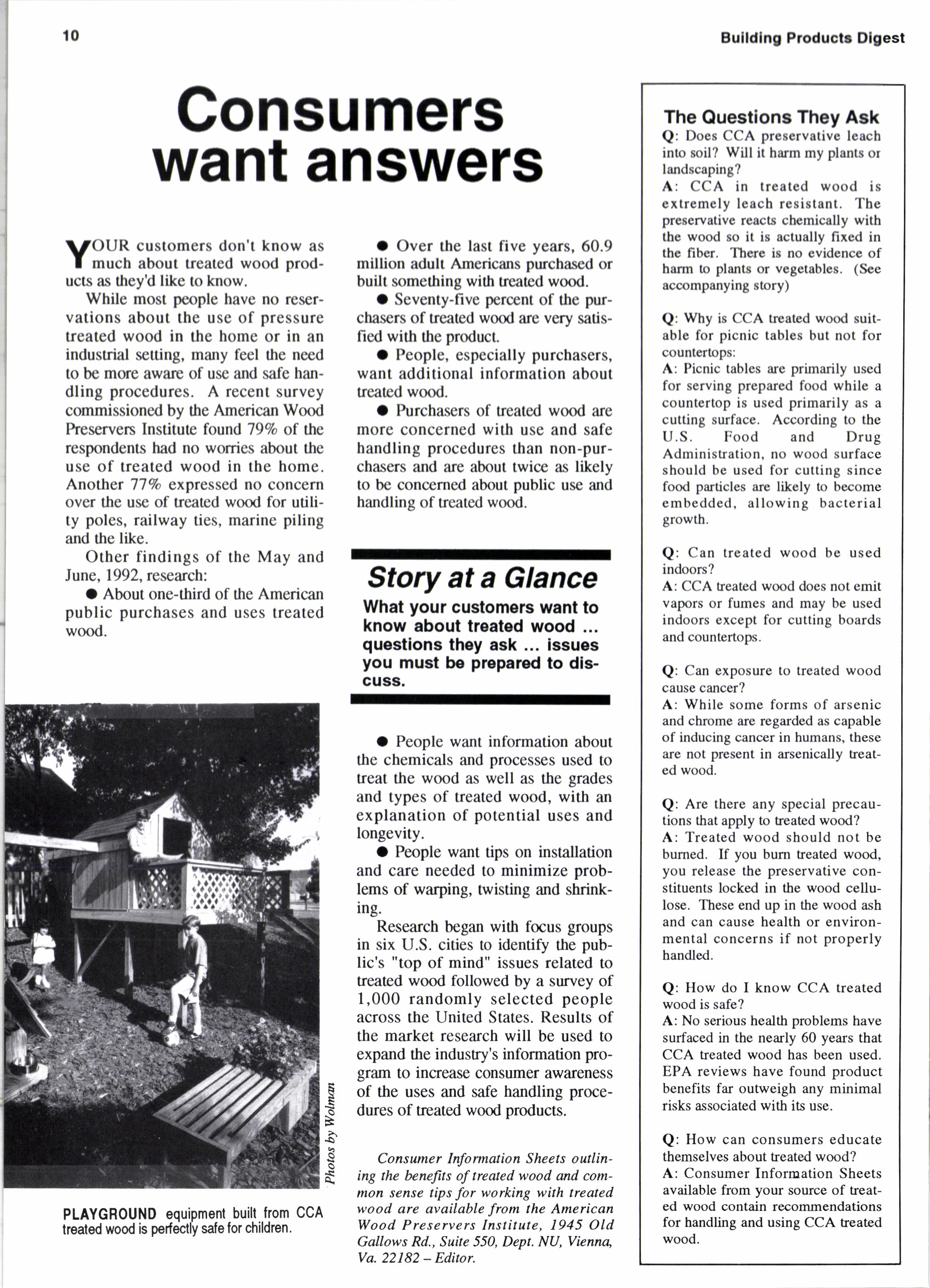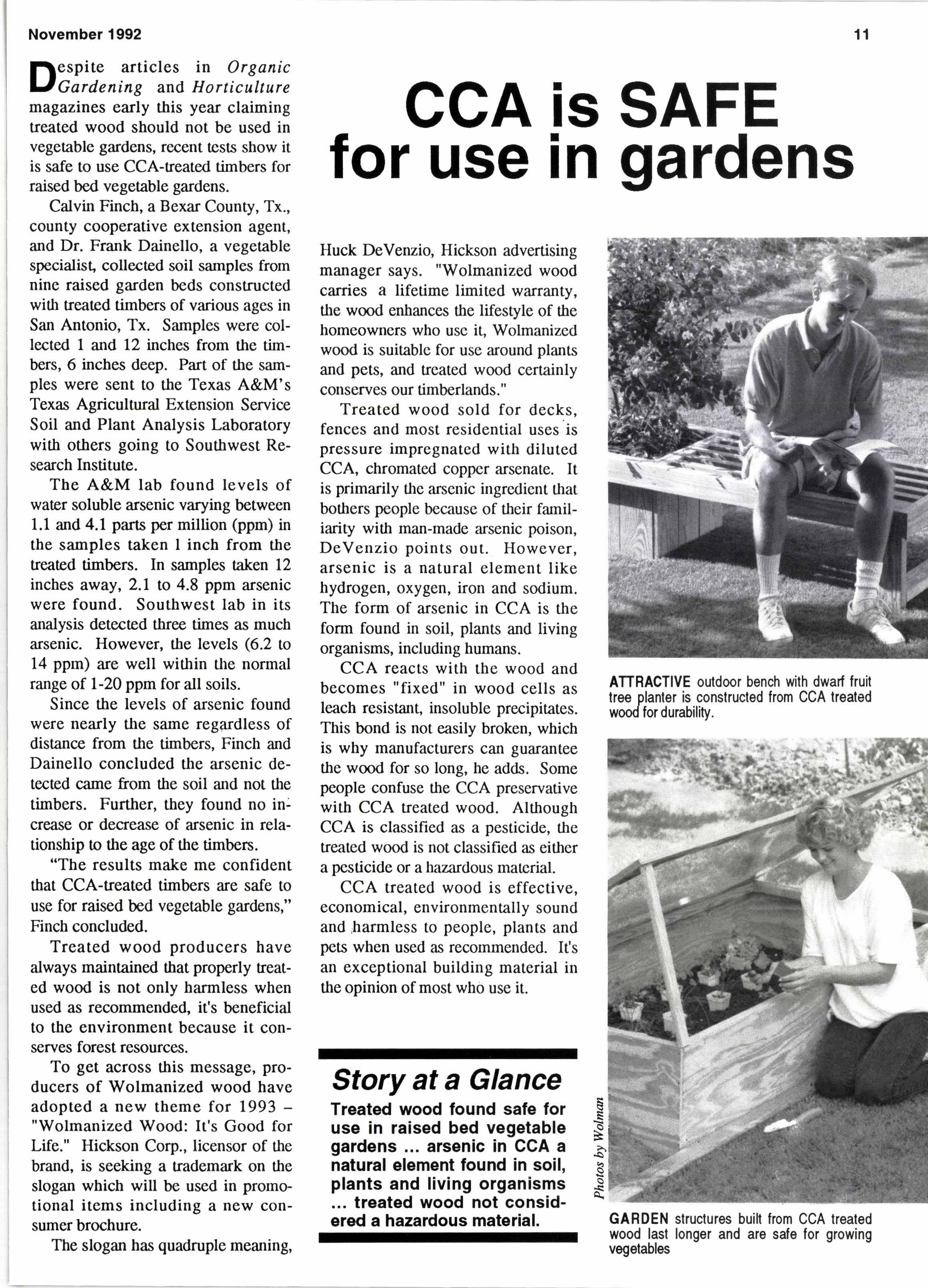
4 minute read
Consumers want answers
\IOUR customers don't know as I mucb about treated wood products as theyd like to know.
While most people have no reservations about the use of pressure treated wood in the home or in an industrial se[ing, many feel the need to be more aware of use and safe handling procedures. A recent survey commissioned by the American Wood Preservers Institute found 797o of the respondents had no wmries about the use of treated wood in the home. Another 777o expressed no concern over the use of treated wood for utility poles, railway ties, marine piling and the like.
Other findings of the May and June, 1992, research: o Over Oe last five years, 60.9 million adult Americans puchased or built something with reated wood. o Seventy-five peroent of the purchasers of treated wood are very satisfied with the product"
O About one-third of the American public purchases and uses treated wood.
O People, especially purchasers, want additional information about treated wood.
O hrrchasen of treated wood are more concerned with use and safe handling procedures than non-purcbasers and are about twice as likely to be concerned about public use and handling of treated wood.
Story at a Glance
The Ouestlona They Ask
Q: Does CCA preecrvativs loacb into soil? Will it harm my plants or landecaping?
A: CCA in treated wood is extremely leach reeigtant. The preservative rcacte cbcmically with thc wood so it is actually fixed in thc fiber. Tbcrc ig no evidenco of hamr to plante or vogetablcs. (Sce accompanying etory)
Q: Wby is CCA treated wood suitable for picnic tables but not for countertopE: o People want tips on installation and care needed to minimize problems of warping, nristing and shrinking. espite articles in Organic Gardening and Horticulture magazines early this year claiming treated wood should not be used in vegetable gardens, rerent tests show it is safe to use CCA-Eeated timbers for raised bed vegetable gardens.
A: Picnic tables are primarily used for serving prepared food wbile a countertop is used primarily as a cutting surface. According to tbe U.S. Food and Drug Administration, no wood surface should be used for cutting since food particles are likely to become embedded, allowing bacterial growtb.
Q: Can treated wood be used indoors?
A: CCA treated wood does not emit vapors or fumes and may be used indoors except for cutting boards and countertops.
Q: Can exposure to treated wood cause cancer?
O People want information about the chemicals and processes used to treat the wood as well as the grades and types of treated wood, with an explanation of potential uses and longevity.
Research began witb focus groups in six U.S. cities to identify the public's "top of mind" issues related to treated wood followed by a survey of 1,000 randomly selected people across the United States. Results of the market research will be used to expand the industry's information program to increase consumer awareness of the uses and safe handling procedures of treated wood products.
Consumer Information Sheets outlining the benefits of treated wood and common sense tips for working with treated wood are available from the American Wood Preservers Institute, 1945 Old Gallows Rd., Suite 550, Dept. NU, Vicnna, Va 22182 - Editor.
A: While some forms of arsenic and chrome are regarded as capable of inducing cancer in humans, these are not present in arsenically heated wood.
Q: Are there any special precautions tbat apply to treated wood?
A: Treated wood should not be burned. If you bum teated wood, you release the preservative constituents locked in tbe wood cellulose. These end up in the wood ash and can cause health or environmental concerns if not properly handled.
Q: How do I know CCA treated wood is safe?
A: No serious health problems have surfaced in tbe neady 60 years that CCA keated wood has been used. EPA reviews have found product benefits far outweigh any minimal risks associated with its use.
Q: How can consumers educate themselves about heated wood?
A: Consumer Information Sheets available from your source of treated wood contain recommendations for handling and using CCA treated wood.

Calvin Finch, a Bexar County, Tx., county cooperative extension agent, and Dr. Frank Dainello, a vegetable specialist, collected soil samples from nine raised garden beds constructed with treated timbers of various ages in San Antonio, Tx. Samples were collected I and 12 inches from the timbers, 6 inches deep. Part of the samples were sent to the Texas A&M's Texas Agricultural Extension Service Soil and Plant Analysis Laboratory with others going to Southwest Research Institute.
The A&M lab found levels of water soluble arsenic varying between 1.1 and 4.1 parts per million (ppm) in the samples taken I inch from the treated timbers. In samples taken 12 inches avtay,2.l to 4.8 ppm arsenic were found. Southwest lab in its analysis detected three times as much arsenic. However, the levels (6.2 to 14 ppm) are well within the normal range of 1-20 ppm for all soils.
Since the levels of arsenic found were nearly the same regardless of distance from the timbers, Finch and Dainello concluded the arsenic detected came from the soil and not the timbers. Further, they found no in: crease or decrease of arsenic in relationship to the age of the timben.
"The results make me confident that CCA-treated timbers are safe to use for raised bed vegetable gardens," Finch concluded.
Treated wood producers have always maintained that properly treated wood is not only harmless when used as recommended, it's beneficial to the environment because it conserves forest resources.
To get across this message, producers of Wolmanized wood have adopted a new theme for 1993"Wolmanized Wood: It's Good for Life." Hickson Corp., licensor of the brand, is seeking a tJademark on the slogan which will be used in promo. tional items including a new consumer brochure.
The slogan has quadruple meaning,










